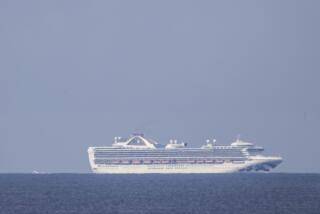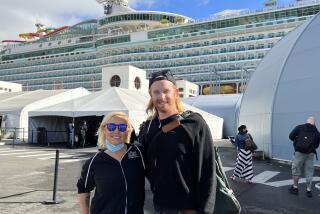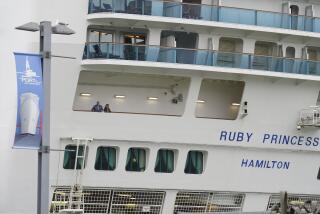Grand Princess arrives in Oakland as coronavirus death toll grows, cases spread
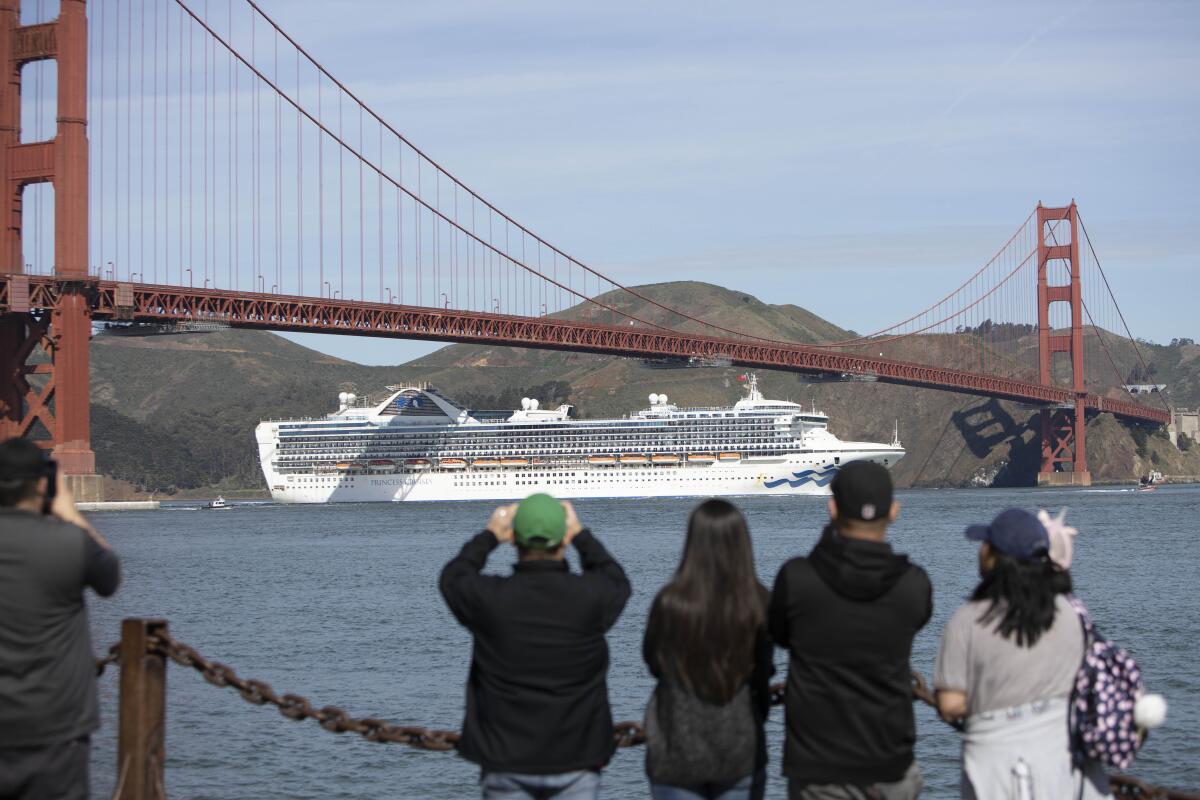
As the Grand Princess cruise ship arrived at the Port of Oakland on Monday, transporting thousands of passengers who were potentially exposed to the coronavirus to quarantine zones, the virus continued its spread across California, with Los Angeles and Riverside counties both announcing additional cases.
Gov. Gavin Newsom has said aggressive steps have been taken to get the passengers off the boat in Oakland without jeopardizing public health. Most will eventually be sent to two California military bases.
Oakland Mayor Libby Schaaf said she was satisfied with the safety measures being taken by state and federal officials for port workers, local emergency crews and the surrounding community.
“We are very glad to play a role, which is the right thing to do to welcome these passengers into safety and to release them from what had to have been a terrifying experience of being trapped on this ship,” Schaaf said Monday afternoon after an event on homelessness in Sacramento.
Schaaf did not say, though, whether she would have been able to refuse use of the port if her concerns had not been addressed. The port sits on state-owned land.
“I never got to the point where I had to find that out,” she said. “I believe every local leader needs to play a part and not let fear dictate what they should do.”
Schaaf said she plans to make public the document that federal and state officials provided her, assuring the Oakland community of safety measures. And she confirmed the passengers needing air travel will be flown on private planes from a private airfield in Oakland.
“I think people should take heart that the different levels of government can work together with a single purpose, with safety in mind,” Schaaf said.
As the boat was docking, another death related to the virus was announced in the state, this one in Santa Clara County. A woman in her 60s had been hospitalized for several weeks and died at El Camino Hospital on Monday morning, the Santa Clara County Public Health Department said in a news release.
She was the third COVID-19 patient in Santa Clara County and the county’s first case of suspected “community spread,” meaning she had neither recently traveled nor had she been in contact with another confirmed case of the virus, officials said.
“This is a tragic development,” Dr. Sara Cody, the county’s health officer, said in a statement. “The Public Health Department is taking necessary, carefully considered steps to slow down the spread of the disease and to protect those at greatest risk. We are facing a historic public health challenge and know this is a very difficult time. Our top priority continues to be protecting the health of our community.”
Meanwhile, Los Angeles County health officials confirmed two new coronavirus cases, one of which may be the county’s first case of community spread of the illness.
L.A. County’s public health department director, Dr. Barbara Ferrer, said one of the individuals who tested positive had a known travel history to Japan. The source of exposure for the second person is currently unknown. Both patients are in isolation, and all of their close contacts will be quarantined for 14 days, health officials said.
The latest cases bring the total in L.A. County to 16. One individual — among the first positive cases in the state — has fully recovered, and the remaining 15 are isolated.
In Riverside County, health officials announced three new cases of the virus. All of the new patients are believed to have traveled to an area with a known outbreak or had contact with a known case, public health officer Dr. Cameron Kaiser said. Two have been isolated at home, and the third is at a Coachella Valley hospital.
Last week, Riverside County announced its first locally acquired case; that patient is at Eisenhower Health in Rancho Mirage. The source of exposure is currently unknown and is considered a result of community spread.
In citing the spread of cases around the world, World Health Organization Director-General Tedros Adhanom Ghebreyesus said Monday: “The threat of a pandemic has become very real.”
He noted that the virus has now infected 100,000 people in 100 countries, but said it is still possible to control the virus through united government action.
“We are not at the mercy of the virus,” he added.
Asian countries that have turned the corner on the virus have shown that even countries with huge outbreaks can control the disease’s spread, Tedros said, adding that government leaders have a responsibility to take action swiftly, especially where major outbreaks have occurred.
“This is an uneven epidemic at the global level,” he said. “Different countries are in different scenarios, requiring a tailored response.”
Tedros said countries with community spread need to consider the most drastic actions, including closing schools and canceling mass gatherings. All countries need to do contact tracing, emphasize the importance of hand hygiene and social distancing and engage the public, he said.
“For all countries, the aim is the same: Stop transmission and prevent the spread of the virus,” he said.
As the number of coronavirus cases in California continues to grow, state public health department officials have issued guidelines for how event organizers should prepare for mass gatherings. While officials did not explicitly instruct the cancellation of any event, they did advise organizers to consider halting events predominantly attended by older or at-risk individuals.
Several schools in California were closed Monday because of the virus, and Stanford University and UC Berkeley both announced they were switching to online classes.
Meanwhile, the city of San Francisco is preparing for a possible outbreak amid an increase in confirmed cases. Officials announced five new cases Monday, bringing the total count to 13. Two of those cases are the result of community transmission.
An oil price war triggered by the spreading coronavirus sent already anxious financial markets into chaos Monday, with stocks diving and crude prices collapsing in a worldwide panic that threatens a global economic recession.
Matthew Guion, 37, a documentary maker, came to Jack London Square in Oakland on Monday to take video of the cruise ship, but it couldn’t be seen from the tourist attraction.
“I am more concerned with getting human beings help than with the president’s agenda of keeping the numbers down,” he said. “What if you were on that ship or you had family members on that ship?”
Of the 2,500 passengers aboard the ship, those in need of immediate medical care or those with preexisting medical conditions will get off the ship first followed by California residents. Before disembarking, they will have their temperatures taken and be assessed for either transfer or treatment at regional medical facilities or quarantine at state military bases.
Passengers with immediate medical needs, which could extend beyond those suspected of having contracted the coronavirus, will disembark first. Earlier, Princess Cruises announced it would offer a full refund to everyone on board, and a credit for a future cruise.
People who live out of state will be taken to federal facilities closer to their homes. Foreigners will be repatriated to their home countries, according to the plan.
At the Port of Oakland gate leading to the cruise ship, authorities turned away a Times reporter. Jen Izeck, 51, a medical social worker who has lived in Oakland for more than 20 years, said docking the ship there is “not great.”
“I think part of the reason Oakland gets this and where this ship is docking is because West Oakland is historically low-income, with lots of minorities who will not give a lot of pushback,” she said. “I think it was a purposeful decision to dock in West Oakland. It is unfortunate they don’t have more of a voice in this.”
Clint Carter, a programmer who works in Jack London Square, also questioned why Oakland was chosen as the docking port for the ship.
“They didn’t put them over in Mill Valley,” he said, referring to the affluent city in Marin County.
But Andrew Igmatenko, 60, an engineer who also works near Jack London Square, said he supported the decision to dock the ship in Oakland.
“They need help,” he said. “They couldn’t live in the ocean. They have to land somewhere.”
Newsom said at a news conference in Oakland on Sunday that the disembarkation and transfer of passengers would take up to three days.
He warned that the situation was “fluid” and could take longer, in part because the port does not regularly deal with cruise ships, and tides and currents allow only small windows of time to enter and leave.
When finished, the Grand Princess would sail out of San Francisco Bay, he said, with the remaining 1,094 crew members — mostly foreign nationals — to be quarantined on board.
Standing next to Newsom, Schaaf sought to assure city residents and port workers that officials were taking every precaution to protect them from infection using “best isolation practices.”
“I’ve been clear with our state and federal partners,” she said, “this is a community that has suffered decades of environmental racism and injustice.”
But she added: “We have to not let our fears dictate or impede our humanity.”
Newsom said authorities had assessed numerous ports and initially planned to direct the ship to the former Naval Air Station Alameda. But “silting issues” made it hazardous for the large ship to dock there, he said, and San Francisco’s port was too close to residential and tourist zones.
The federal government was sending so-called hasty teams on Sunday to board the ship to get a sense of what healthcare workers will face on the ground, he said, while the 10-acre site in Oakland’s outer harbor was being cleared and fenced for the onshore processing to begin. The city said at no time will local residents come into contact with passengers disembarking the ship.
Following the completion of the mission, the Port of Oakland site will be fully remediated and decontaminated by immediately removing temporary structures and pressure-washing the entire site with a bleach solution to disinfect it.
It is unclear how deeply the virus has spread aboard the ship. Several days ago, the Coast Guard sent 45 tests, and 21 came back positive for COVID-19, the disease caused by the new coronavirus.
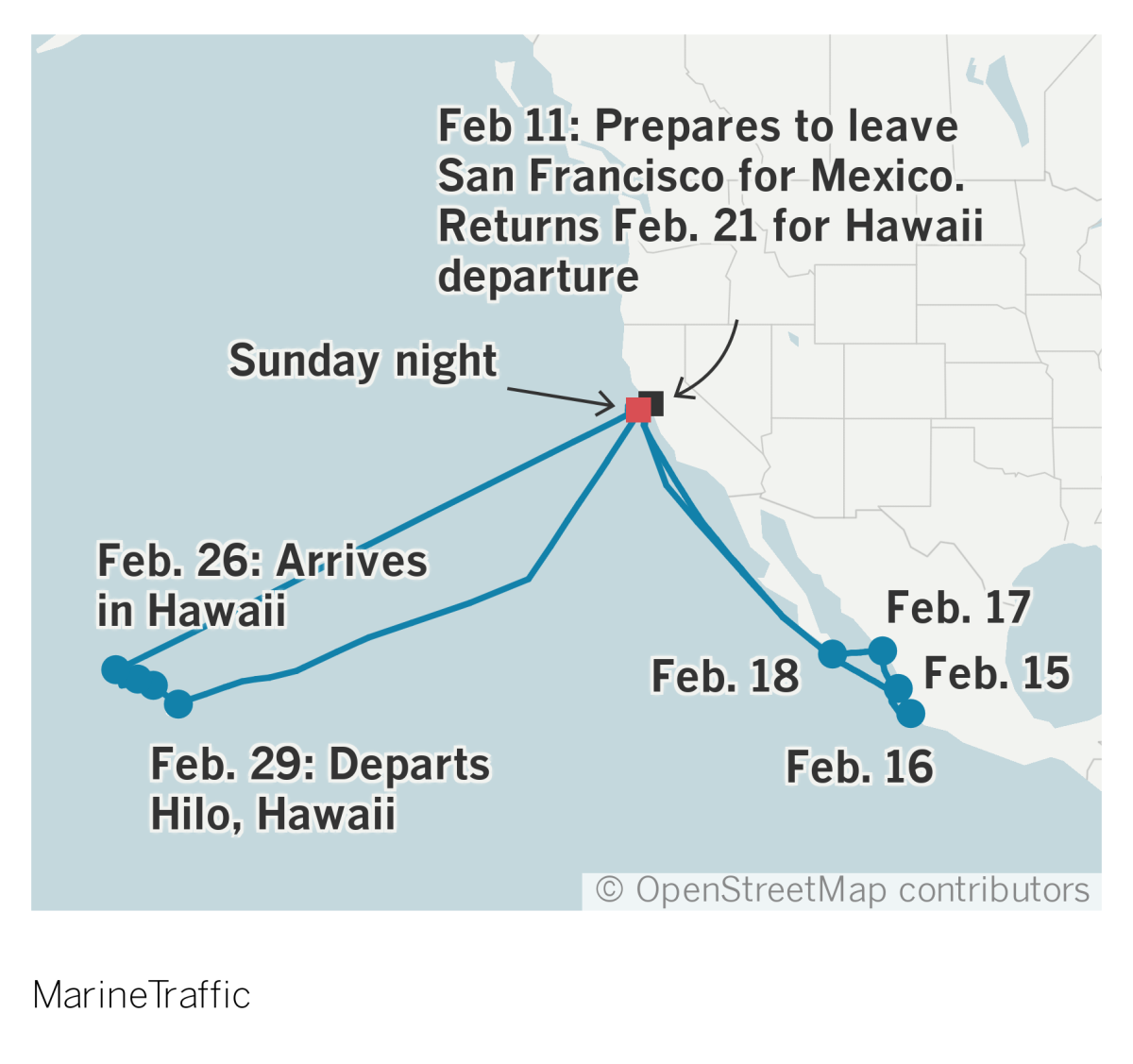
The virus first infected an unknown number of passengers aboard the previous voyage on the ship, a round-trip sail from San Francisco to various ports on Mexico’s Pacific Coast, between Feb. 11 and Feb. 21. Seventy of those guests held over for the next voyage, from San Francisco to Hawaii and back.
The remaining guests, including 1,540 Californians, simply disembarked with no knowledge of an outbreak aboard. Twelve of them have tested positive in the state, and one man later died, in Placer County.
While state and federal health officials are still reaching out to and trying to monitor those earlier passengers, those aboard the Hawaii trip will be tightly isolated, authorities said.
Newsom said most of the 962 California residents aboard the Grand Princess who did not need immediate medical attention would be taken to Travis Air Force Base in nearby Solano County for 14 days of quarantine, with a smaller number going to the Marine Corps Air Station in San Diego, officials said. The remaining American passengers would be sent to military bases in Texas and Georgia, while foreign passengers would be flown to their home countries.
Officials were also working to prepare Oakland International Airport for the charter flights to the other bases, and out of the country. “There will be no contact with the general population terminals at Oakland Airport,” Newsom said.
Debbie Loftus, a passenger from Wisconsin, said she was pleased Newsom spoke directly to passengers and thought the news conference, which she watched, represented a “change in attitude.”
“It is nice that he is now welcoming us into California; a few days ago he did not want us anywhere near his state,” Loftus said.
President Trump said Friday that he preferred the passengers not be allowed to disembark on U.S. soil, but added that he would let his coronavirus task force, led by Vice President Mike Pence, make the call.
Newsom, noting the normally combative relationship between his and Trump’s administrations, said Pence’s team “has been truly exceptional.”
The infections aboard the Grand Princess followed the outbreak aboard its sister ship, the Diamond Princess, which was quarantined at the Port of Yokohama in Japan last month. Some 700 people aboard the Diamond Princess were infected, and eight have died.
Experts said the confinement of passengers aboard the Diamond Princess created conditions highly conducive to the spread of the virus on board.
Interviewed on CBS’ “Face the Nation” on Sunday, Surgeon General Jerome Adams promised that sick passengers would “get the medical care that they need, that they’re appropriately evacuated” and also that people would leave the ship “as quickly and as safely as possible.”
The U.S. State Department on Sunday advised that “U.S. citizens, particularly travelers with underlying health conditions, should not travel by cruise ship,” noting an “increased risk of infection of COVID-19 in a cruise ship environment.”
“While the U.S. government has evacuated some cruise ship passengers in recent weeks, repatriation flights should not be relied upon as an option for U.S. citizens under the potential risk of quarantine by local authorities,” the federal agency said in a statement posted on its website.
Newsom urged the cruise ship industry to look beyond short-term gain and “own this moment.”
Speaking more generally about the virus, he said the number of Californians testing positive jumped from 88 Saturday to 114 on Sunday, but he emphasized that the number was expected to rise as testing became more widely available.
While only 788 tests have been conducted statewide so far, California currently has kits for 8,000 individuals and that a private lab, Quest Diagnostics in San Juan Capistrano, will be able to process 2,000 tests each day beginning Monday, if needed. There are also 15 public labs processing tests, including a facility in Richmond, where tests for the Grand Princess passengers were conducted.
More than two hours offshore, stuck in their cabins, many passengers were struggling with claustrophobic conditions, but were happy to learn they could go outside for fresh air, in batches.
Loftus, the passenger from Wisconsin, said that many uncertainties remained that are causing her anxiety.
“This is all going to be a very new experience, going to a military base in Oakland, getting on what I assume is not going to be a commercial airline or ... going someplace I’ve never been, she said. “Not sure what the accommodations are going to be like and how long we’re going to be held there. Yes, it’s a little bit anxiety-producing but [we] will handle it minute by minute.”
Matt LaGesse’s mother and aunt are on the ship, and he has been trying for days to get information, with little luck.
LaGesse said he was angered by the president’s comments about potentially keeping passengers on board, and what he felt was a lack of planning and leadership around the crisis. Despite details given by Newsom, he remained frustrated and uncertain about what would come next.
LaGesse said he has not been contacted about the disembarkation plan by authorities or the cruise line.
“As a family member and son of a mom that I really, really love ... I’m scared and nervous and disappointed,” he said Sunday. “You expect your leadership ... to give you clear messaging so that you can understand the plan.”
Times staff writers Hannah Fry, Colleen Shalby, Ruben Vives and John Myers contributed to this report.
More to Read
Sign up for Essential California
The most important California stories and recommendations in your inbox every morning.
You may occasionally receive promotional content from the Los Angeles Times.
